A watchlist is a curated list of securities selected for potential trading or investment. Its purpose is to monitor specific assets for opportunities, such as price changes or relevant news, allowing individuals to react swiftly to market developments. Components of a financial watchlist can vary based on personal investment goals and strategies, but typically include stocks, bonds, ETFs, commodities, or currencies. Essential information like current price, daily high and low, percentage change, volume, and market capitalization are often included for each asset. Managing a financial watchlist involves regular updates to reflect evolving market conditions and personal financial objectives. This could mean adding new assets as opportunities arise, removing those no longer deemed attractive, and continuously reviewing the list for performance trends and key market movements. Therefore, a well-maintained watchlist is a powerful tool for informed financial decision-making. A watchlist serves as a real-time snapshot of selected financial assets. It's an essential tool in financial management, allowing investors to stay abreast of market fluctuations, conduct in-depth analysis, and identify favorable buying or selling opportunities. A well-managed watchlist can be a game-changer, providing a clear view of potential investment options and enabling quick, informed decisions. A substantial part of any watchlist, stocks represent shares of ownership in a company. Keeping an eye on specific stocks can help investors understand company performance, industry trends, and market sentiment. Stocks in a watchlist can range from blue-chip companies to small-cap stocks, depending on the investor's strategy. Bonds and other fixed income securities provide steady income, making them an essential part of any diversified watchlist. They are particularly important for risk-averse investors and those nearing retirement. ETFs allow investors to diversify their watchlist without the need to monitor numerous individual securities. They are popular for their low costs and flexibility, as they can be bought and sold like individual stocks. Commodities like gold, silver, oil, and agricultural products are often added to watchlists as a hedge against market volatility and inflation. For investors interested in the foreign exchange market, tracking currency pairs is crucial. Changes in currency values can have significant impacts on other asset classes. Before creating a watchlist, investors must clarify their financial goals. Are they seeking long-term growth, income, or capital preservation? Understanding one's goals will guide the selection of appropriate assets for the watchlist. Once goals are established, investors must research potential investments. This involves understanding the asset's fundamentals, its past performance, and its potential for future growth. The chosen assets should align with the investor's risk tolerance and investment timeline. The organization of the watchlist is crucial for easy tracking. Investors can group assets based on asset class, industry, or potential for growth or income. A watchlist isn't a "set it and forget it" tool. It requires regular reviews and updates, as market conditions and personal financial goals can change. Frequent review helps investors stay in tune with their potential investments and make timely decisions. The watchlist serves as a basis for investment decisions. When an asset on the watchlist reaches a predetermined price or experiences a significant event, it might be time to buy or sell. Technology can significantly simplify watchlist management. Many online brokerage platforms offer built-in tools for creating and managing watchlists. These tools can send alerts when an asset reaches a specific price or experiences significant volume changes. A watchlist can help investors achieve diversification, reducing risk by spreading investments across different asset classes and sectors. By including a mix of stocks, bonds, ETFs, commodities, and currencies, investors can balance potential returns against potential risks. A well-curated watchlist can help identify broader market trends. For instance, a rising trend in tech stocks or a decline in oil prices can signal larger economic shifts. Recognizing these trends can guide investment strategy and risk management. While adding assets to a watchlist is important, knowing when to remove them is equally crucial. Warning signs could include consistently poor performance, fundamental changes in a company's business, or shifts in market or economic conditions. While it's tempting to add every interesting asset to a watchlist, this can lead to information overload. It's best to focus on a manageable number of assets that align with your investment goals and strategy. Some investors set up a watchlist and then ignore it. However, regular updates are essential to account for changing market conditions and investment goals. A watchlist is a tool, not a magic wand. It should be used in conjunction with other research and analysis. Making investment decisions based solely on watchlist observations can lead to hasty and ill-informed decisions. A good rule of thumb is to keep the watchlist simple. Including too many assets can make it difficult to track and analyze performance. As previously mentioned, regular updates to the watchlist are essential. This includes removing assets that no longer meet investment criteria and adding new ones that do. Some investors find it helpful to maintain multiple watchlists for different strategies, such as long-term growth, income generation, or speculative investments. Most online brokerage platforms offer watchlist features. These allow users to track selected assets, view real-time price data, and receive alerts based on specific criteria. Websites like Bloomberg, Yahoo Finance, and MarketWatch allow users to create free watchlists. These sites also offer news and analysis that can help investors make informed decisions. Numerous mobile apps offer watchlist features. These apps provide the added convenience of tracking assets on the go. A financial watchlist, a curated list of assets an investor chooses to monitor, plays a crucial role in informed investment decision-making. It provides a real-time snapshot of potential investment opportunities, enabling investors to keep track of market trends and the performance of specific assets. A well-structured watchlist comprises various components, including stocks, bonds, ETFs, commodities, and currencies, offering a diversified perspective to the investor. Moreover, the management of a watchlist is a dynamic process, requiring regular updates and reviews in line with changing market scenarios and the investor's financial goals. It serves as a valuable tool for spotting investment opportunities and making timely decisions. Thus, a financial watchlist is a pivotal instrument in an investor's arsenal, driving strategic investment moves and enhancing financial management proficiency.Definition of a Watchlist
Importance of a Watchlist in Financial Management
Components of a Financial Watchlist
Stocks and Equities
Bonds and Fixed Income Securities
Exchange-Traded Funds (ETFs)
Commodities
Currencies and Forex
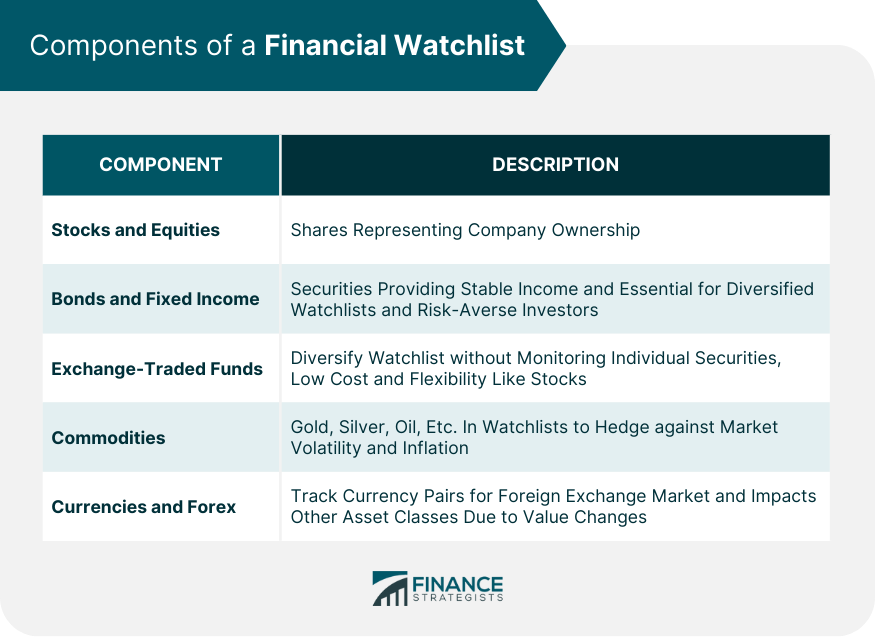
Creating a Financial Watchlist
Identifying Financial Goals
Researching and Selecting Potential Investments
Organizing the Watchlist
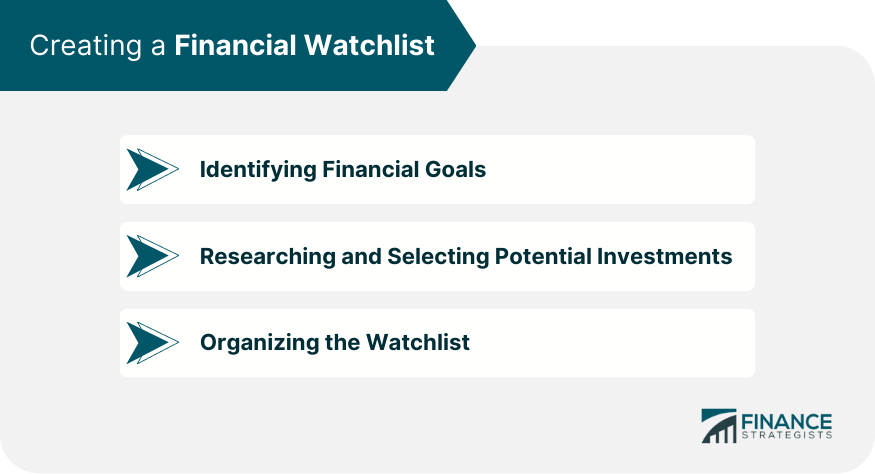
Managing a Financial Watchlist
Regular Review and Update of the Watchlist
Making Decisions Based on the Watchlist
Using Technology for Watchlist Management
Watchlist and Risk Management
Using Watchlist for Diversification
Identifying and Tracking Market Trends With a Watchlist
Warning Signs: When to Remove an Asset From Your Watchlist
Common Mistakes in Using a Financial Watchlist
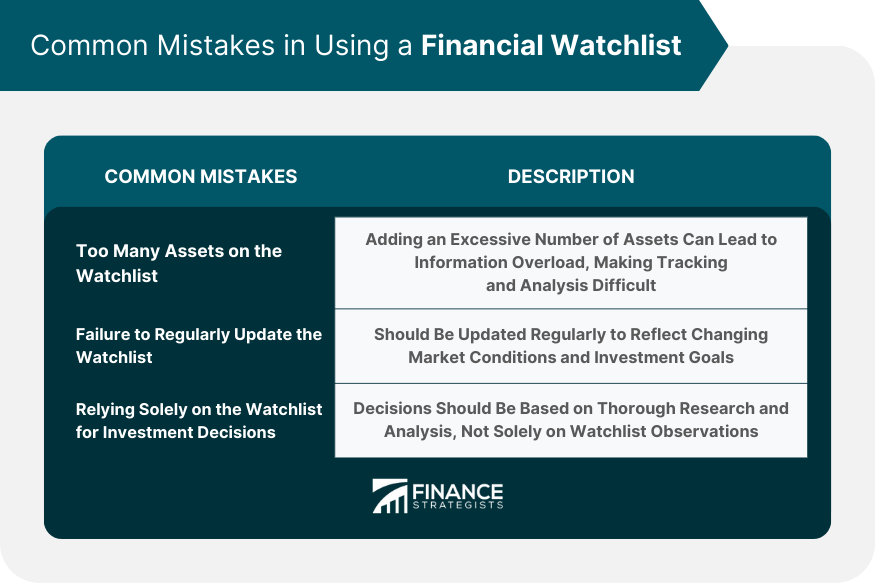
Too Many Assets on the Watchlist
Failure to Regularly Update the Watchlist
Relying Solely on the Watchlist for Investment Decisions
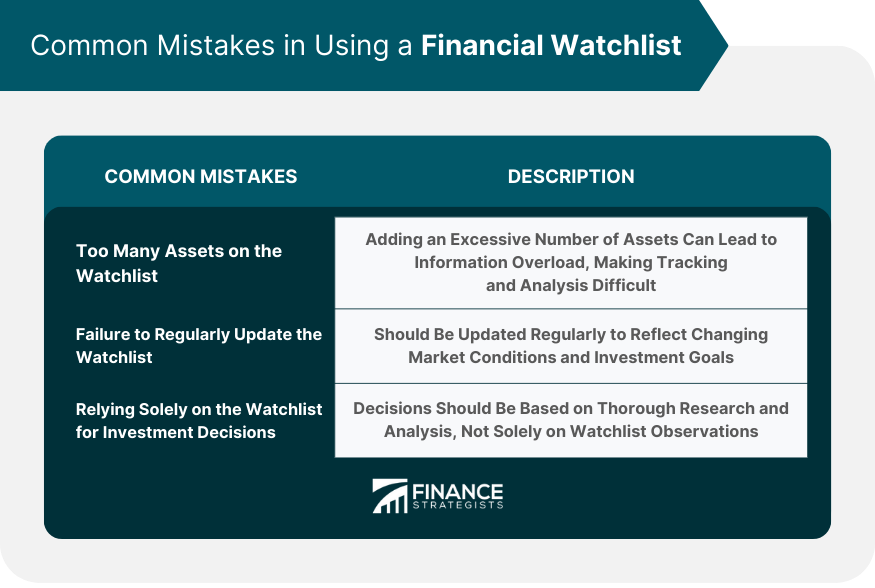
Best Practices in Using a Financial Watchlist
Keeping the Watchlist Simple and Manageable
Regularly Researching and Updating the Watchlist
Using Multiple Watchlists for Different Investment Strategies
Tools and Platforms for Building a Financial Watchlist
Online Brokerage Platforms
Financial News and Analysis Websites
Mobile Apps for Watchlist Management
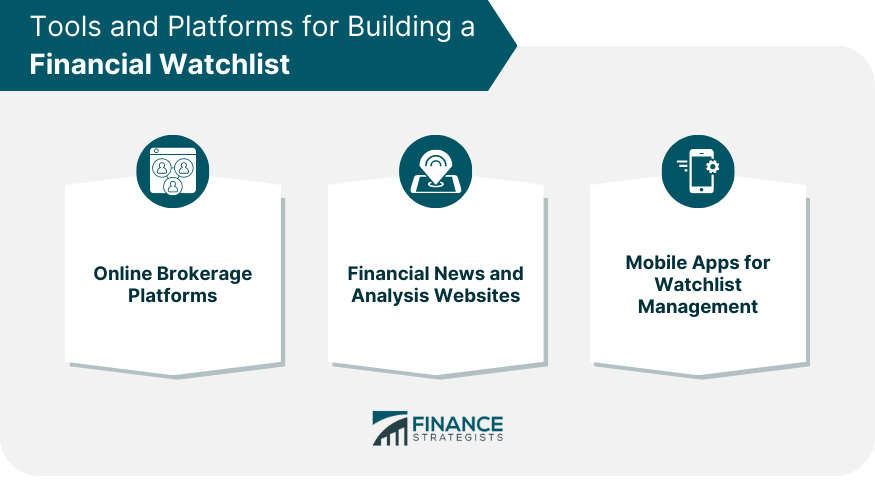
Conclusion
Watchlist FAQs
A watchlist is a list of selected securities monitored for potential trading or investment opportunities. It's important as it helps investors track market movements and make informed decisions.
A financial watchlist often includes various securities like stocks, bonds, ETFs, commodities, or currencies, along with their key information like current price, volume, and market capitalization.
Effective management of a financial watchlist involves regular updates to reflect changing market conditions, adding new assets as opportunities arise, and removing those no longer deemed attractive.
No, a watchlist doesn't guarantee successful investments. It's a tool to help monitor potential opportunities. Final investment decisions should consider a variety of factors.
Yes, you can have multiple watchlists. Investors often maintain separate watchlists for different investment strategies, asset classes, or time horizons.
True Tamplin is a published author, public speaker, CEO of UpDigital, and founder of Finance Strategists.
True is a Certified Educator in Personal Finance (CEPF®), author of The Handy Financial Ratios Guide, a member of the Society for Advancing Business Editing and Writing, contributes to his financial education site, Finance Strategists, and has spoken to various financial communities such as the CFA Institute, as well as university students like his Alma mater, Biola University, where he received a bachelor of science in business and data analytics.
To learn more about True, visit his personal website or view his author profiles on Amazon, Nasdaq and Forbes.











